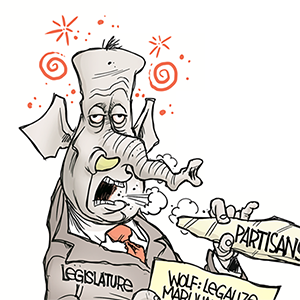The US is approaching a dangerous measles precipice, scientists say
Published in News & Features
LOS ANGELES — In December, Stanford School of Medicine colleagues Dr. Nathan Lo and Mathew Kiang got to talking.
Childhood immunization rates were slowly but steadily falling nationwide, from 95% in the years before the pandemic to less than 93% in the 2023-24 school year.
If even that relatively small decline in vaccinations for measles, mumps and rubella (MMR); diphtheria, tetanus and pertussis (DTaP); polio; and varicella held, they wondered, what would U.S. infectious-disease prevalence look like in 10 years, or 20? What would happen if vaccination rates went up by a little bit, or fell by a whole lot?
Lo and Kiang put together a statistical model representative of the U.S. population and ran the results.
They found that if current vaccination rates hold steady over coming decades, measles — currently spreading in many parts of the country, but primarily in the Southwest — will once again be endemic in the U.S. within 25 years.
Their results were published Thursday in the Journal of the American Medical Assn.
Measles was technically "eliminated" in the U.S. in 2000, meaning the disease became rare enough — and immunity widespread enough — that even if a case or two were to arise within a community, local transmission would quickly grind to a halt. In the 25 years since, there have been 10,570 measles cases, including the 800 people sickened in the outbreak that began in west Texas in January.
But at current vaccination rates, Lo and Kiang estimate there could be as many as 851,300 measles cases between now and 2050. By their calculations, in that time frame, more than 170,000 people will be hospitalized, and nearly 900 will experience debilitating and potentially deadly neurological complications. And some 2,550 people will die.
We wouldn't be back in the pre-vaccine days, when measles affected more than 4 million people annually and regularly claimed the lives of at least 400 U.S. children per year. But the disease would once again become endemic, meaning ever-present at some baseline level, like influenza, which sickens millions and kills thousands in the U.S. every year.
"Right now we should really be trying to up vaccination rates," said Kiang, an assistant professor of epidemiology and population health. "If we just kept them the way they are, bad things are going to happen within about two decades."
Other vaccine-preventable diseases would also probably pop up in the coming quarter-century — 190 cases of rubella, 18 of poliomyelitis, eight of diphtheria, according to the Stanford team's models.
But none would be as likely to come roaring back as measles, far and away the most infectious of the bunch.
Parents could no longer reliably count on herd immunity to keep newborns too young to vaccinate safe from the disease. Pediatricians and emergency room doctors would see patients with measles-related complications they'd likely never encountered in their training or careers.
"I've read a reasonable number of these kinds of papers, and I think that this one is exceptional," said Dr. Adam Ratner, a New York City pediatric infectious-disease specialist. "The numbers of cases and adverse outcomes from measles and other vaccine-preventable diseases that they estimate are extremely concerning. These are diseases that U.S. families are not used to thinking about or seeing, and they may become commonplace again in the near future unless we reverse course."
Even relatively small increases in childhood immunization would prevent that scenario, said Lo, an assistant professor of infectious diseases. If MMR vaccine rates went up by 5%, the country would see only about half as many measles cases in the next 25 years that it saw in the last 25.
"A small fraction of the population here can really make the difference in terms of tipping us into more safe areas," he said.
Both authors said they considered a further decline in vaccination rates the more likely outcome. Since they first conceived of the study, President Trump took office and appointed as secretary of Health and Human Services Robert F. Kennedy Jr., a longtime critic and skeptic of established vaccine science.
After promising during confirmation hearings that he would not alter the U.S. childhood vaccinations schedule, Kennedy told HHS employees in February that he plans to investigate childhood immunizations.
Further declines in vaccination rates could have significant consequences, the researchers found. Were vaccination rates to fall another 25% from where they are today, the U.S. would see 26.9 million measles cases between now and the end of 2050, along with 80,600 deaths from measles, rubella, polio and diphtheria combined.
"To put this in perspective, most physicians in the U.S. haven't seen a single case of any of these diseases because we have very effective vaccines," said Dr. Kristina Bryant, a pediatric infectious diseases physician at Norton Children's Hospital in Louisville, Ky.
At a 50% drop, a once-unthinkable scenario, the disease would become endemic again within five years. Over the next 25 years, there would be 51.2 million cases of measles, 9.9 million cases of rubella and 4.3 million cases of poliomyelitis. More than 159,000 people would die from vaccine-preventable diseases. Some 51,000 children would have life-altering neurological complications, and 5,400 would be paralyzed by polio — a disease for which there have been no cases reported since 1993.
A decline of that magnitude in vaccination rates "would really take something quite unprecedented," Kiang said. But when it comes to public health, he said, "what we've learned over the past few months is that our imagination needs to be larger for what is possible."
©2025 Los Angeles Times. Visit at latimes.com. Distributed by Tribune Content Agency, LLC.







Comments